
Gearbox is a protocol that introduces a new DeFi primitive termed “Credit Accounts”, facilitating loans where borrowers can deploy more capital than they’ve deposited. By bridging lending and prime brokerage functionalities within a single protocol, Gearbox empowers users to margin trade on Uniswap, leverage farm on Curve, and engage in various other DeFi activities with up to 10x more capital.
| Key Features | Description |
| Composability | Gearbox integrates seamlessly with other DeFi protocols, allowing users to utilize leverage across multiple assets and platforms, without isolating funds in proprietary pools. |
| Modularity | The protocol’s architecture is designed for plug-and-play functionality, enabling customization and risk segmentation to suit different use cases. |
| Zero funding rates | Unlike perps, Gearbox executes leverage trades with spot assets on third-party protocols, eliminating the need for funding rates (they only have borrow rates) and enhancing capital efficiency. |
| Leverage as a Service | External protocols can leverage Gearbox’s infrastructure to offer leverage to their users, without requiring modifications to their existing architecture. |
| Permissionless | Users have the freedom to execute complex trading strategies within Credit Accounts, utilizing Gearbox’s multicall features to streamline interactions. |
| Non-custodial | Gearbox ensures users retain control of their funds at all times, unlike centralized exchanges that impose leverage parameters and custody requirements. |
| Community-driven | With a focus on community governance, Gearbox operates without a central entity dictating on-chain actions, prioritizing the needs and preferences of its user base. |
Unique to Gearbox is the concept of Credit Accounts, allowing borrowers to utilize multiple assets as collateral in order to access leverage offered by lenders in return for an interest rate payment.
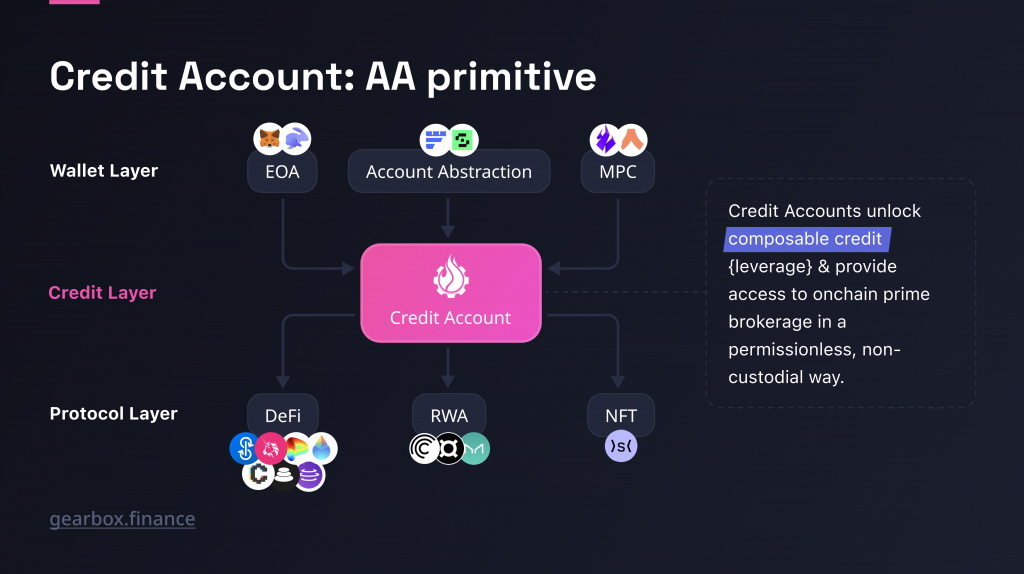
Gearbox serves as a kind of “leveraged DeFi wallet” by providing a comprehensive platform for managing and maximizing your DeFi activities with leverage. Users decide their leverage, where to deploy the capital, and for how long.
While there are no predefined vaults or yield farming strategies that users are forced to abide by, Gearbox limits the number of assets and external protocols it supports. This is a security measure that is in place to ensure that funds are not lost through untrustworthy or badly engineered protocols.
Whitelist of allowed tokens and protocols
Gearbox operates by engaging and matching two types of user profiles: passive lenders and borrowers. Passive lenders provide liquidity to the protocol, earning yields on their deposited assets, while borrowers leverage this liquidity to enhance their trading or investment positions, paying interest in return.
| Passive Lenders (or Liquidity Providers) | Borrowers |
| These are individuals or entities who provide assets to the protocol seeking passive yield with lower risks.
Similar to platforms like Compound, lenders deposit their assets into Gearbox and receive interest-bearing tokens in return, representing their share of the liquidity pool. These assets are then utilized by borrowers within the protocol, generating APY for the lenders. |
Borrowers consist of traders and farmers seeking to increase their position by borrowing liquidity at multiples of their collateral.
Borrowers can access leverage up to 10x their notional size, amplifying their trading or investment activities. This leverage power allows borrowers to magnify their potential returns but also increases their risk exposure. |
Unlike traditional trading platforms, Gearbox does not custody assets or control secondary market liquidity. Therefore, there are no funding rates associated with the protocol. Additionally, Gearbox ensures that assets are not isolated within its protocol by facilitating all trades and farming operations on third-party protocols such as Uniswap, Curve, and Yearn.
This approach enables Gearbox to integrate seamlessly with a wide range of protocols, leveraging composability to enhance liquidity and trading opportunities. Positions taken by traders and farmers are liquidated by third-party liquidators before the assets of passive lenders are exposed to downside risks.
In the event of liquidation, the protocol returns the assets to the protocol pools, ensuring that Gearbox can maintain the integrity of the underlying assets and minimize risks for passive lenders.
One of the key components of Gearbox are Credit Accounts, which match and connect passive lenders with borrowers moving funds through a Credit Manager smart contract. In Gearbox, Credit Accounts hold both the user funds and the borrowed funds. Each user in Gearbox has their own trading account – this is where leverage lives and from where all operations will be performed.
Each account operates under a fixed asset denomination, and its total value is calculated based on the assets it holds and their prices from a price oracle. The liabilities include the borrowed amount, interest accrued, and initial funds. The system ensures safety through a health factor, where accounts are liquidated if their health factor falls below 1, preventing undercollateralization in volatile market conditions.

Credit Accounts in Gearbox are non-custodial, smart contract-based accounts offering leverage to users for various DeFi strategies. Users can deposit collateral to open a Credit Account, then borrow assets to execute leveraged trades or investments across integrated DeFi protocols. The funds on a Credit Account represent the collateral being used for debt, and users can operate these funds by margin trading on DEXs like Uniswap or Sushiswap, earning yield on Yearn, arbitraging peg between stablecoins on Curve, capturing basis from interest rate differentials on money markets…

Credit Accounts isolate risks and enable efficient capital utilization, allowing for leverage up to 10x. Users manage risk through collateralization ratios, with liquidation mechanisms in place to protect borrowed funds. This design enhances DeFi investment strategies by providing flexible, leveraged exposure to a range of protocols without requiring asset transfer between protocols.
Operations within Credit Accounts are restricted by two policies: the allowed contracts list and the allowed tokens list. These policies mitigate risks associated with vulnerable smart contracts and highly volatile assets, ensuring the security and stability of Credit Accounts. Gearbox maintains an evolving list of Allowed Tokens and Allowed Contracts, both being actively managed by governance.

Gearbox has already conceptualized integrations with prominent DeFi platforms such as Uniswap, Sushiswap, Convex, Yearn, Curve, Balancer, Aura, and others. However, the integration process may vary for farming or liquidity providing due to the diverse nature of asset pools and price oracles across different protocols.

Note that while the AllowedList serves as a permission box, the actions within it are permissionless. Users have the freedom to apply leverage, execute trades, and manage assets within the confines of the Allowed List permissions. There are no pre-made strategies or vaults, allowing for customizable and decentralized operations.
Furthermore, this AllowedList is regularly updated to reflect the latest additions and changes. Users can consult the on-chain contracts for the most up-to-date information, ensuring transparency and accuracy in protocol governance.
Gearbox features a modular architecture designed to support flexibility and seamless integration with other protocols. One of the reasons behind this approach is to be integrated with existing and new protocols in an open-source manner.

A modular architecture enables segmentation of risks, personalized rates, collateral limits, and other mechanisms. This customization empowers Gearbox to cater to different user groups, including farmers, traders, liquidity providers, and participants in sophisticated LP-ing, NFT, and RWA leveraging activities.

Leveraging its modularity, Gearbox can extend leverage to a wide range of assets, including long-tail assets, without significantly increasing risks for passive lenders. This diversification enhances the protocol’s ability to service diverse user needs and preferences.
Due to the modular architecture of Gearbox, each user has their own Credit Account(s), reducing gas costs associated with executing trades. Additionally, Credit Accounts are borrowed from the protocol, minimizing deployment costs for new users.
When trading on Gearbox, your Credit Account becomes the collateral for external protocols: both your initial funds and the amounts you borrowed from Gearbox’s passive lenders. By continuously monitoring the portfolio composition, the protocol can determine its value at all times, calculated in the underlying borrowed asset which the user opened the Credit Account in.
The protocol uses a risk model to continually assess the quality of a trader’s portfolio, and liquidations are based on the Health Factor (HF) and Threshold Weighted Value (TWV) of positions. Liquidations are critical for maintaining the health and stability of Credit Accounts, ensuring solvency while enabling leveraged operations.

TWV(t)=∑min(Qi(t), ci(t) * pi(t) * LTi where ci is the balance of an asset, pi is the price of that asset, Qi is the Quota amount for the ith asset and LTi is the liquidation threshold.
TV(t)=∑ ci(t) * pi(t) where ci is the balance of an asset and pi is the price of that asset
LTi = 100% – Liquidation Premium – Liquidation Fee
Any Credit Account with a health factor below 1 is at risk of being liquidated. Liquidations can be initiated by anyone, and they involve selling off assets from the Credit Account to repay the borrowed amount. This process helps to prevent losses for liquidity providers and maintain the overall health of the protocol.

Anybody can participate in liquidations in a permissionless manner by running a liquidator bot.
Quotas are like individual credit limits, applied to each Credit Account. They determine the maximum exposure to a particular collateral asset for each Credit Account.
Quota Fees, established by main governance, are static and incurred when obtaining or increasing a quota.
Each allowed asset in the pool has parameters:
Each $GEAR voter can distribute their votes between different assets and choose whether to increase or decrease the interest rate.
Let g↑i(t) be the number of votes to increase the interest rate for the i-th asset and g↑i(t) be the number of votes to decrease it. Then the interest rate is defined as:

Gearbox has a dynamic approach to calculate Quota interest rates, aiming to balance liquidity within the protocol and ensure equitable compensation for lenders. A key component of this system is the Quotas Cumulative Index (QIi(t)), which aggregates the value of utilizing a quota for each asset over time. This index is adjusted with every modification in interest rates or quota usage, maintaining the cost of quota usage in line with the protocol’s financial health.

This mechanism ensures that the cost associated with quota usage is continuously updated to reflect the current market conditions and the protocol’s liquidity needs, allowing for a dynamic and responsive system for managing and pricing asset quotas within the Gearbox ecosystem.
Interest charges for each user’s quota usage are determined based on changes in the Quotas Cumulative Index since their last activity. This method ensures that users are billed accurately for their usage over time. The change in a user’s quota debt (Δdj(tn)) is calculated as follows, illustrating the accrued interest based on their quota allocation and the time elapsed:

Quota Revenue (QR) encapsulates the total interest accrued from all users’ quota usage. It is refreshed with each rate adjustment, aligning the protocol’s revenue with the actual quota usage across all assets. This synchronization is vital for sustaining the protocol’s financial stability and providing transparency in its revenue generation from quotas.

This structured methodology for calculating interest rates and managing quotas enables Gearbox to adaptively respond to market dynamics and user activities, ensuring a sustainable and equitable system for leveraging digital assets.
Gearbox has an organic interest rate model to dynamically adjust the borrow rates within its pools, based on the utilization parameter. This model is important for managing liquidity and ensuring that the rates are fair and responsive to the actual usage of the protocol’s resources. Similar to Aave’s linear interest rate model, Gearbox incorporates a nuanced approach with a two-point model, further refined by the addition of quota usage rates as determined by $GEAR voters.
Organic Interest Rate Calculation:
To compute the pool’s liquidity dynamics, Gearbox uses the Expected Liquidity (EL(t)) and Cumulative Index (CI(t)) metrics. Expected Liquidity reflects the anticipated amount of funds in the pool, assuming all users settle their Credit Accounts and repay their debts. The Cumulative Index aggregates the value of borrowed funds over time, capturing the cost of borrowing. These are formulated as:
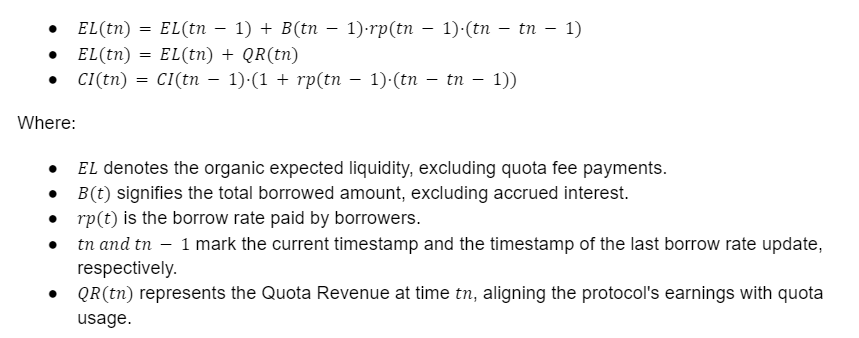
Borrow Rate Determination:
The borrow rate (rp(t)) is then calculated based on the pool’s expected liquidity and the total borrowed amount, adjusted for quota interest payments (BI(t)), using a tiered model defined by governance through constants r0,r1,r2,r3, U1, U2. This model ensures that the borrow rates are adjusted according to the pool’s utilization ratio, with safeguards to prevent borrowing that would push the utilization ratio above a certain threshold (U2).
Gauges decide the extra interest rates borrowers pay on their quotas. $GEAR stakers freeze tokens and vote to set these rates, similar to Curve Gauge’s distribution of rewards.

Rates change per epoch (typically 7 days), influencing borrowers’ costs and lenders’ rewards. Stakeholders can vote to adjust rates, aiming to balance borrower affordability and lender returns.

Gauges serve as a mechanism to determine the additional APY on top of the usual utilization curve for each asset, effectively billing extra for riskier collaterals held in a Credit Account. Stakeholders, including passive lenders, leverage borrowers, and protocol integrators, play pivotal roles in shaping these rates through $GEAR staking and voting.
Passive lenders typically aim to maximize their APY by voting for higher gauge rates across all assets. Conversely, leverage borrowers seek to minimize their borrowing costs by voting to decrease gauge rates for specific assets they utilize. Protocol integrators, desiring increased adoption of their services, may vote to decrease rates for relevant assets, making their protocols more attractive for Gearbox borrowers.
These rates, decided by $GEAR stakers on-chain, are applied per-block, similar to regular borrow rates, and are subject to periodic epochs lasting seven days or longer. Each epoch begins every Monday at 12:00 UTC, providing a structured framework for governance decisions. The extra rates collected from borrowers are shared with passive lenders and accumulated in the Fee Guard, contributing to the overall sustainability and incentive structure.
The motivation for creating Gearbox stemmed from the need to innovate within the DeFi space of the time. The original idea was conceptualized during the MarketMake hackathon by ETHGlobal in January-February 2021.
Initially, the goal was to establish a secondary market utilizing liquidity from Uniswap pools, aiming to resolve issues related to liquidity pool balancing and enabling leverage without funding rates. However, as demand grew for more assets and higher leverage while maintaining decentralization, the protocol evolved to accommodate these needs.
Mikael first came up with the idea and took it to the finals of the ETHGlobal MarketMake 2021 Hackathon. This first proof of concept attempted to make a Uniswap leverage trading engine
The initial core members and contributors started working on the project between January and August 2021. During this initial period the technical paper, architecture, and overall framework for Gearbox were created. Next, efforts were made to educate the community about Gearbox and its forthcoming launch. Additionally, audits and security testing were conducted on the core contracts in preparation for the December 2021 launch.
The DAO-first launch model was proposed during the ETHGlobal Online event. In this model, control over the protocol was relinquished by the initial core members from day one, with decisions regarding collaterals, allowed policies, and more being made through DAO voting.
The initial distribution of tokens was carried out across several phases, with a diverse range of participants receiving tokens. These tokens were initially non-transferrable, and decisions regarding their transferability were left to the DAO. Later on a unique token distribution mechanism called Credit Account Mining was introduced. It involved designated wallets paying gas costs to deploy accounts and receiving $GEAR tokens in return.
The goal of Credit Account Mining was to ensure that Gearbox had a sufficient number of Credit Accounts available for leverage users to rent, thereby reducing the need for users to deploy expensive smart contracts each time they required leverage. Eligible addresses included early community members, developers, contributors, and governance participants of other protocols. The list included holders of LobsterDAO NFTs, snapshot governance participants of various protocols, on-chain governance participants, LPs of Element Finance, and GTC claimants, among others.
This approach aimed to select users familiar with governance processes, increase visibility for the protocol, and prevent any single group from dominating the distribution.
Multisig roles were established for financial-treasury and technical purposes, with delegates appointed to streamline community involvement. The initial core team ceased to have control over the protocol, and the DAO became the primary decision-maker.
As time passed, decisions regarding assets, protocols, and other financial parameters were made through DAO voting, with community participation facilitated through forum proposals and snapshot page voting.
The Gearbox v2 version aimed to validate the protocol’s design for safety and efficiency, focusing on achieving specific goals:
Initially, it was assumed that Leverage Trading might not have a competitive advantage on Gearbox compared to competitors like GMX and other perps DEXs, given the curated UI for leverage farming. However, with Gearbox’s low cost of borrow, efficient Leverage Trading with size was observed.
With v2, Gearbox aimed to offer composability without requiring users to navigate multiple protocols manually. The introduction of Multicall simplified leverage user interactions, with over 80% of positions being opened using this feature, exceeding initial expectations.
While initially expected to attract lower-risk lenders, the concept of lending pools took longer to gain traction, partially due to perceptions of post-FTX risk. Nevertheless, Gearbox achieved significant milestones across various aspects of its operations.
On the risk management and safety front, the protocol accrued $0 bad debt and experienced no emergency pauses. With over 75% organic utilization and $100M+ Total Value Locked (TVL) across major assets like $USDC, $DAI, and $ETH, Gearbox demonstrated robust performance. Additionally, the presence of numerous independent liquidators and multiple risk monitoring systems further enhanced security.
In terms of community engagement and partnerships, Gearbox has established strategic partnerships with prominent DeFi platforms like Yearn Finance, Balancer Boosted Pools, Frax Finance AMOs, and Brahma Finance, enhancing its ecosystem and attracting significant capital inflows.

The DAO also continued to move forward in terms of governance participating, promoting active participation in DAO discussions. Monthly DAO reports ensured accountability and provided insight into fund allocation. The transition to the OBRA governance framework and plans to move towards on-chain governance further reinforced the commitment to decentralized decision-making.
With v3 the goal was to introduce significant enhancements in lending, scalability, revenue generation, user experience, and tokenomics.


Gearbox also evolved its governance model to address past limitations and enhance operational efficiency. The new model introduced permissionless execution of queued Governance Improvement Proposals (GIPs) and a Controller role for streamlined decision-making.
The deployment of v3 marked a significant advancement, introducing margin trading with PURE liquidity and specialized UIs for margin trading and farming.

The protocol’s modular architecture facilitates diverse asset pools and risk segmentation, addressing the challenge of simplifying a generalized protocol into a user-friendly product interface. Leveraging v3’s composable leverage, users can engage in margin trading without derivatives or funding rates, tapping into spot liquidity from various sources.

With v3, Gearbox PURE introduced margin trading with real, spot assets, offering leverage without LPs or counterparties. Utilizing lending pools and Credit Accounts, users can borrow up to 10x funds against collateral from Gearbox. Trades are settled on DEXes like Uniswap and Curve, ensuring deep liquidity and fairer trading conditions. This design enhances margin trading by addressing backend concerns, offering users a seamless UX for efficient trading.

Gearbox is not a standard DeFi money market where users deposit collateral to borrow in an overcollateralized manner. Unlike traditional models like Aave and Compound, Gearbox involves two types of users: borrowers who want access to leverage, and lenders who want to earn an interest on their deposit.

Composable leverage, a core feature of Gearbox, offers unprecedented flexibility and efficiency by allowing users to craft their yield farming strategies. Unlike conventional leverage, where users are restricted to long or short positions and subject to predetermined liquidation parameters, Gearbox empowers users to design intricate strategies within the boundaries of its allowed list policy, which safeguards against security risks.
At the heart of Gearbox’s spot leverage lies the concept of composability, epitomized by the integration of smart contracts across different protocols, often referred to as “money legos.” This interoperability enables users to maximize capital utilization by seamlessly deploying leverage across various DeFi platforms. Notably, Gearbox does not maintain its own order book or trading environment, allowing leverage obtained on the platform to be employed across multiple protocols.
Gearbox is a protocol offering a DeFi primitive for others to build on top of, aiming to become the base layer for other projects to innovate and offer leveraged strategies.
Credit on chain has evolved through various phases, each introducing innovative mechanisms and expanding the possibilities within DeFi:

The next opportunity for DeFi credit lies in improving capital efficiency while maintaining robustness and avoiding bad debt. Despite the advancements, most protocols fall short in providing optimal capital efficiency due to conservative collateralization ratios (Loan-to-Value ratio < 1). However, there’s a whitespace opportunity for highly capital-efficient protocols, aiming to achieve both robust collateral profiles and efficient borrowing.
With v3, Gearbox aims to address this whitespace by introducing a protocol that combines capital efficiency with robust collateralization, enabling users to go beyond current credit capabilities.
The adoption of Gearbox can also be measured based on the number of integrations. As Gearbox integrates with more protocols and offers new leveraged strategies, its network effects will become stronger, further making it more attractive for others to tap into its liquidity.
Gearbox is currently operational on Ethereum and Arbitrum, although the code is EVM compatible and the DAO has already started discussions to deploy on other Ethereum L2s.
Gearbox aims to improve capital efficiency in decentralized finance (DeFi) through the introduction of Credit Accounts. These are isolated smart contracts designed for undercollateralized interactions with DeFi protocols, allowing leveraged trading, farming, and other financial activities.

Credit Accounts function as decentralized custodies for assets, enhancing safety through liquidations when certain thresholds are breached. This allows the protocol to facilitate access to leverage across various DeFi instruments and projects, ensuring cross and isolated margin trading.
The formulas below are introduced in the whitepaper and describe relevant concepts to understand the protocol operations

If PnL > 0 both the protocol and liquidity providers earn money. In that case the protocol mints additional LP tokens and sends them to the Treasury. Otherwise the protocol uses the Reserve Funds to protect LPs from losses.
There are two primary types of users in Gearbox:

Because of this dual participation, Gearbox attracts active market participants, passive investors, external projects, and other DAOs to build strategies on top or tap into the protocol’s liquidity.
Gearbox unlocks a multitude of potential use cases beyond traditional leverage trading, offering users enhanced flexibility and capital efficiency in their DeFi endeavors.
| Leveraged Farming | Users can amplify their yield from farming activities by leveraging stablecoins, staked ETH, and more, with leverage ratios of up to 10x. |
| Basis Trading | Gearbox enables users to engage in basis trading without funding rates, allowing for simultaneous short and long positions. This allows users to capitalize on differences in interest rates across platforms while maintaining a delta-neutral position. |
| Arbitrage of Correlated Assets | With leverage, users can exploit price differentials between correlated assets over mid to long time frames, maximizing arbitrage opportunities and potential profits. |
| Customized Strategies | Unlike traditional platforms with limited options, Gearbox empowers users to create and execute complex trading strategies tailored to their preferences. Users have full control over leverage levels, asset allocation, and trading decisions. |
| Undercollateralized Loans | Gearbox enables undercollateralized loans by leveraging on-chain data to assess the value of various assets, including tokens, LP positions, reputation scores, NFTs, and real-world assets (RWA). This opens up new avenues for borrowing and lending within DeFi. |
Essentially, Gearbox gives users more capital to work with, and they can decide where to deploy it. This flexibility makes it possible to capitalize on yield opportunities and amplify returns with leverage.
For instance, consider the example presented in the image below, where a user is selling $ETH for stables in order to earn yield on Yearn.

Gearbox pools provide passive lending opportunities without impermanent loss, custody concerns, or liquidations. When you supply capital to a pool, you receive Diesel Tokens (dTokens), which automatically earn interest and fees proportional to your share of the pool. These tokens grow in value over time and can be staked to earn additional rewards, such as $GEAR tokens.

The yield in Gearbox comes from multiple sources:
Similar to standard money markets like Aave and Compound, the utilization curve determines the borrowing Annual Percentage Yield (APY) based on the utilization ratio of the pool. This curve introduces three states: cheap to borrow, acceptable rate for borrowing, and expensive to borrow.
The profitability of LPs depends on the pool utilization ratio U — the higher utilization, the higher interest rate. The borrow APY is calculated as:

Gauges establish extra interest rates on top of the regular ones, further increasing APYs for liquidity providers. These extra rates are shared between passive lending pools and the DAO.
In the future, the protocol may introduce Alpha pools, which are built on top of existing pools and offer additional APY. Alpha pools help isolate risks without fragmenting liquidity, allowing passive lenders to opt-in and earn additional rewards without compromising their existing positions.

To participate as a passive lender on Gearbox, all you have to do is:
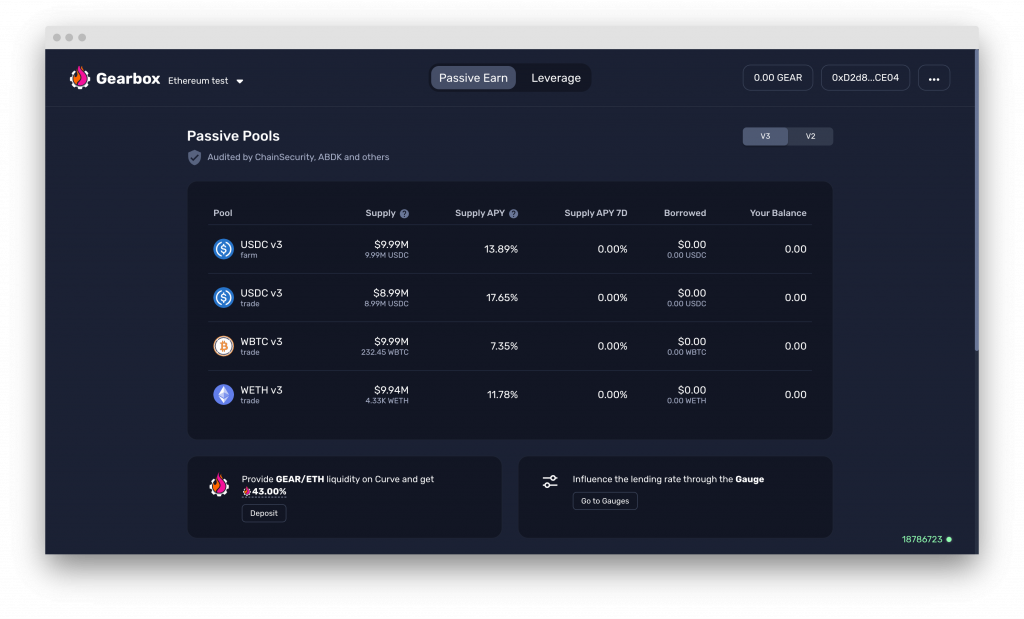
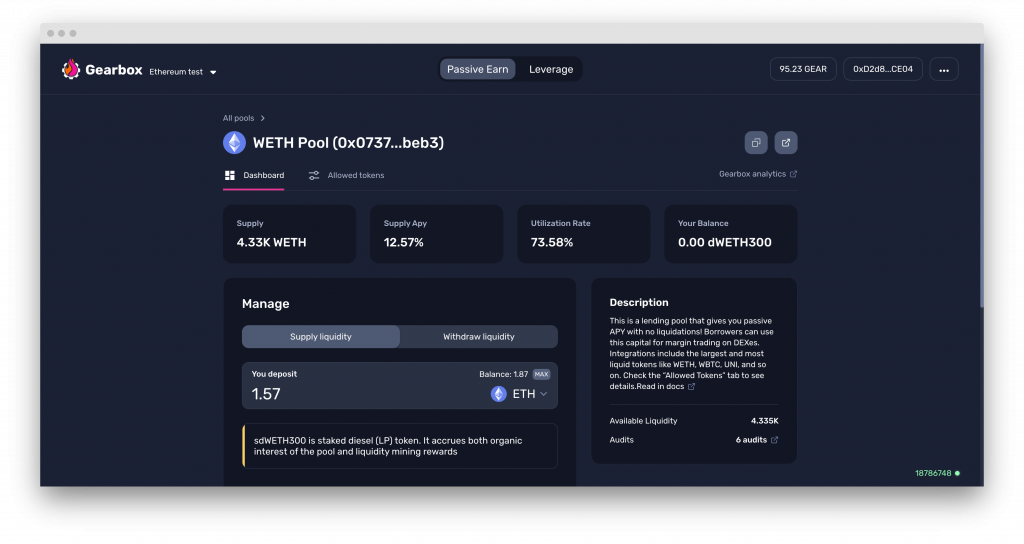
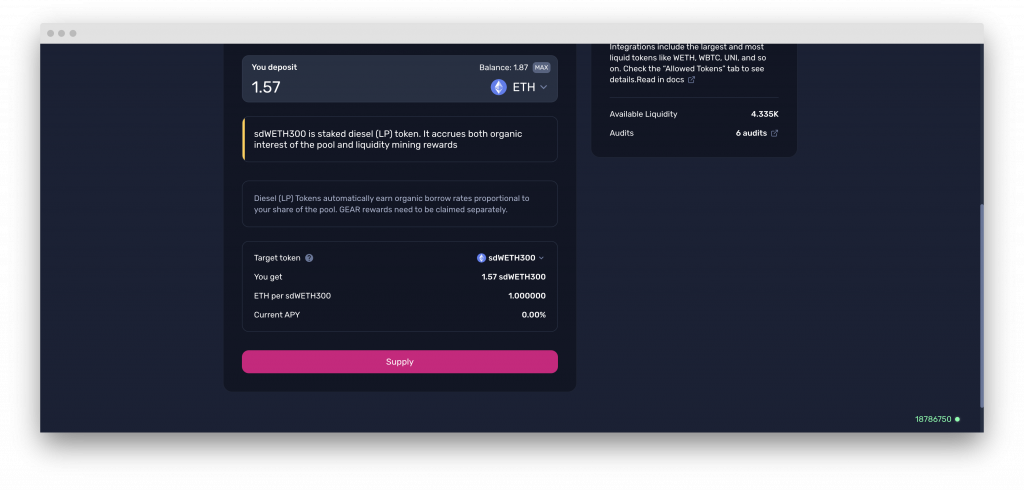
Now you have staked dTokens, which automatically compound organic APY from borrow and quota rates. You don’t need to do anything else. Extra token yields, like $GEAR, accrue to your staked dTokens, but you need to claim them manually.
Gearbox’s extended view dashboard shows assets borrowers are trading and farming with, helping you assess risks in different pools. You can adjust your lending strategy based on this information or stake the $GEAR you earned to increase rates for certain borrowers, improving your risk/reward ratio.
To withdraw liquidity, follow the same steps as above, but click on the “withdraw liquidity” tab in Step 2.
Note that if a pool’s utilization is too high, governance can adjust lend-borrow parameters to make lending more expensive, incentivizing repayment of lender capital and reducing pool utilization.
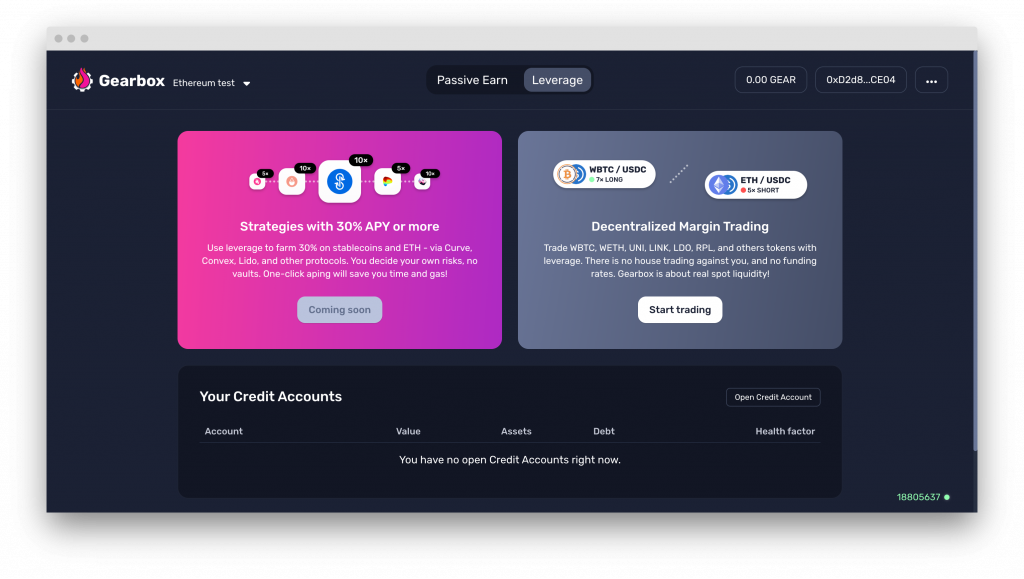
| For Margin Trading | For Leverage Farming | For Manual Operations |
|
|
|
| https://pure.gearbox.fi/ | https://app.gearbox.fi/strategies/list | https://app.gearbox.fi/accounts |
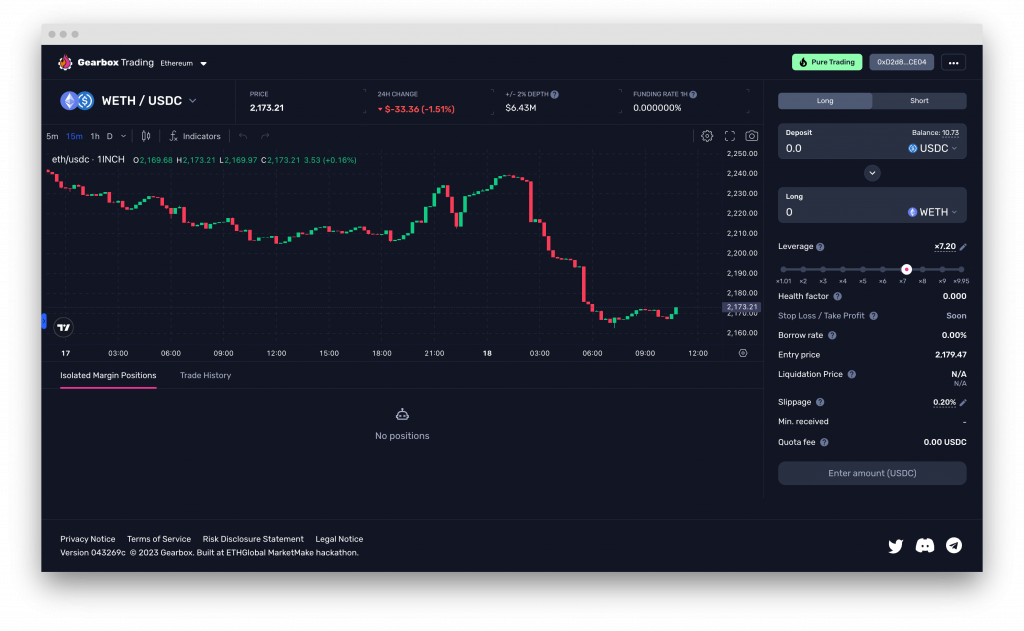
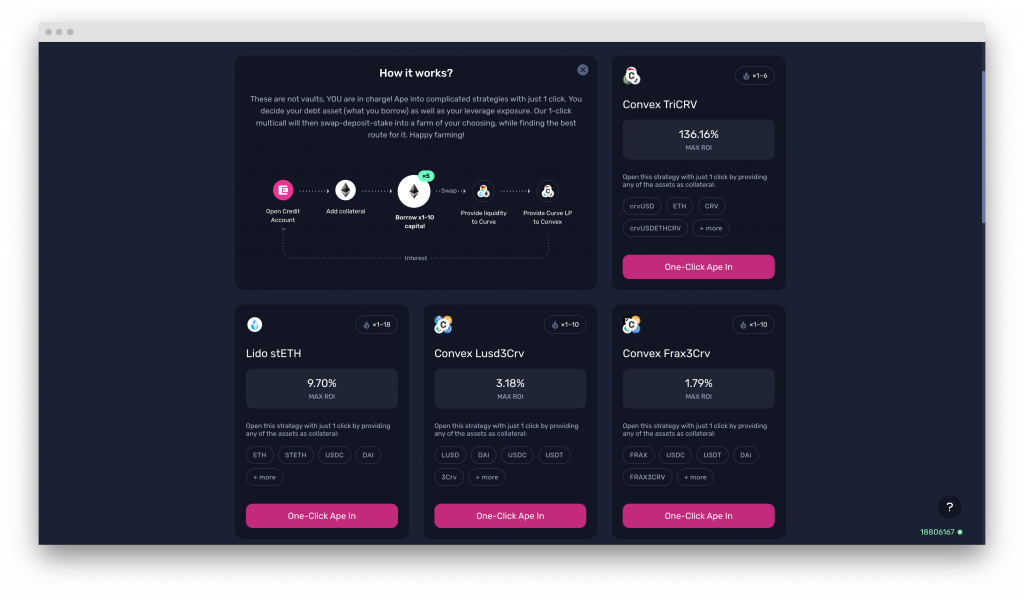
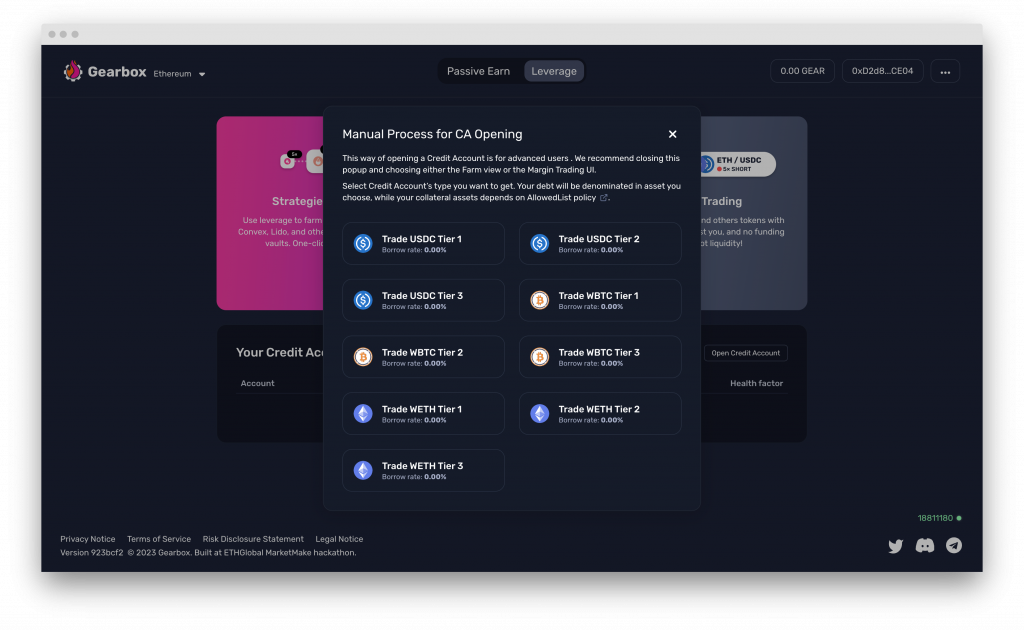
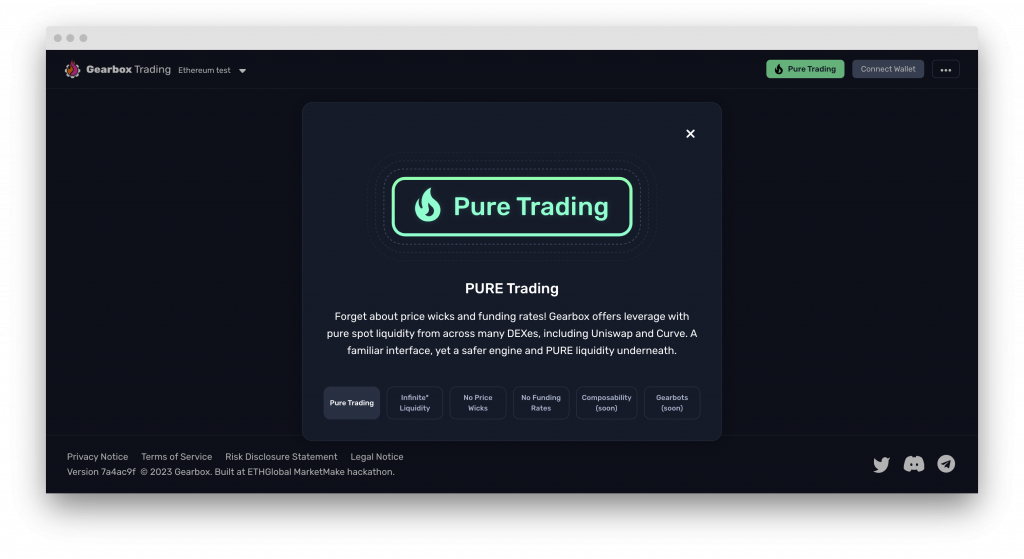
The PURE Margin Trading interface on Gearbox offers:
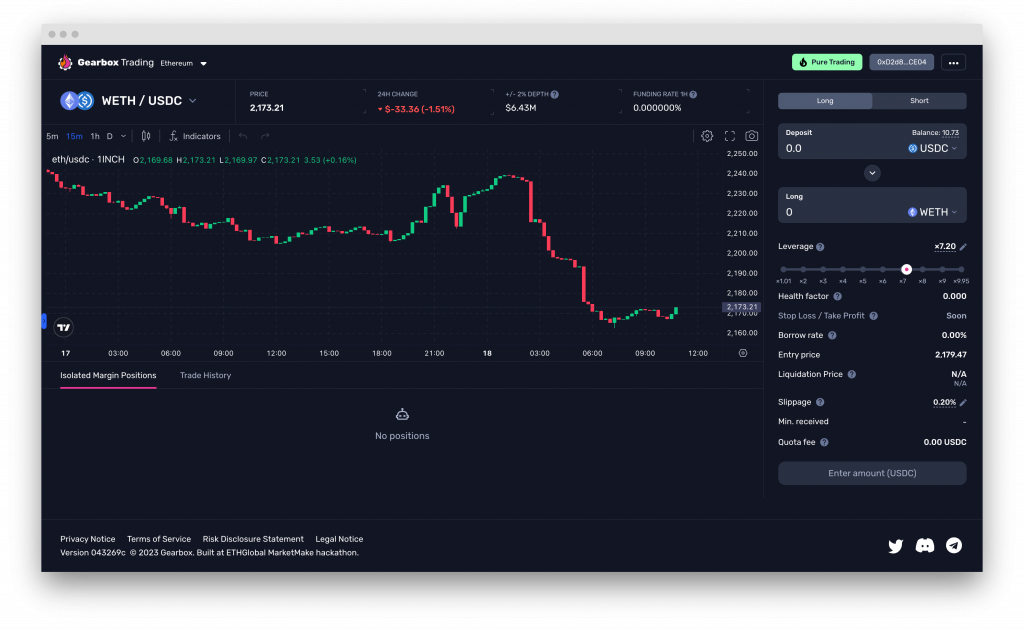
Trading with PURE allows for trading with real spot assets, avoiding perpetuals or synthetic derivatives. This allows traders to access the existing deep liquidity of DEXs like Uniswap, Curve, or Balancer.
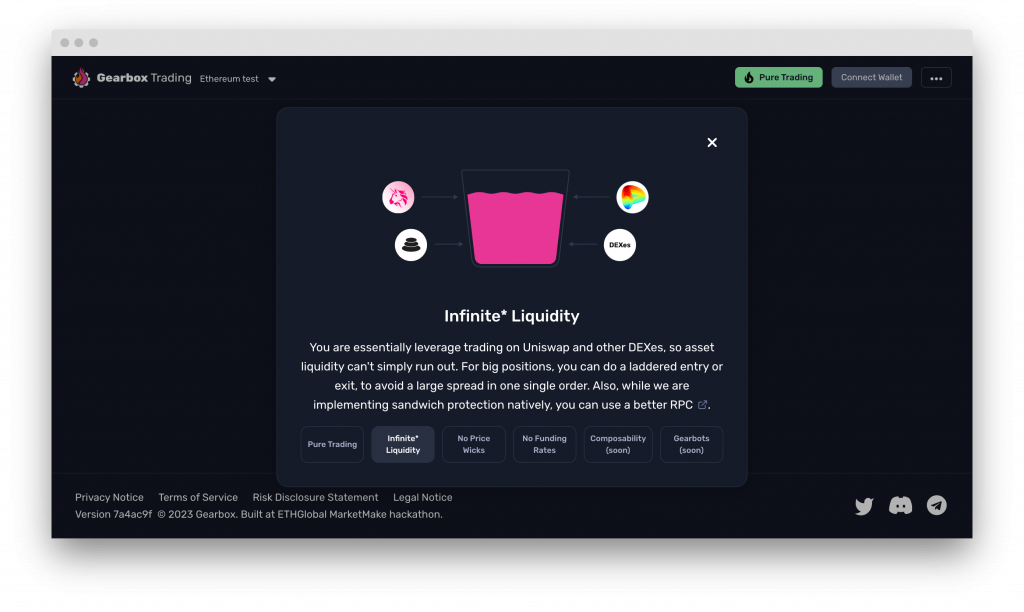
Unlike perpetuals, there are no funding rates, making it more capital efficient. Instead of paying a funding fee periodically, users will pay a borrowing rate. This is also helpful when we take into account the fact that there are no price wicks, mitigating liquidations from quick and price fluctuations.
Some of the trading strategies that can be performed include:
Users interested in going long on $ETH with $USDC can take advantage of the Boosted Long feature offered by Gearbox. This feature not only allows for a leveraged position but also enables users to earn farming rewards.

The process for establishing a Boosted Short position mirrors that of a Boosted Long, with the key difference being the market position users take. By activating Boosted Trade while going short on $ETH, users can receive rewards that may help cover or exceed the borrowing costs.
Gearbox’s approach to Boosted Trades streamlines complex trading strategies. The PURE interface is designed to be user-friendly, inviting users to take advantage of innovative trading options that enhance the benefits of their positions. Whether opting for a long or short stance, Gearbox’s features are geared towards enhancing user profitability and trading efficiency.
Leverage farming on Gearbox offers various opportunities for users to optimize their DeFi strategies:
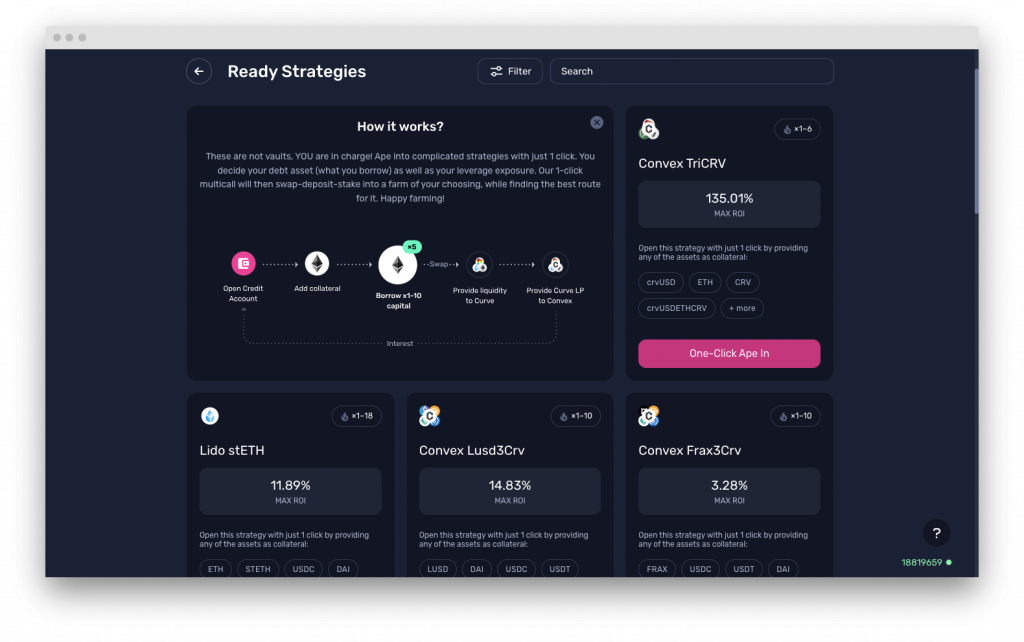
Leverage farming provides advantages to users by enhancing capital efficiency, and improving the user experience when interacting with a wide variety of DeFi dApps.
Some concrete examples of strategies include:
Open leveraged positions in predefined protocols in 1 transaction. They let you go from not having a Credit Account to having a Credit Account open and ready to start farming the strategy of your choice. You still have the freedom to choose the leverage, the debt asset, the collateral…
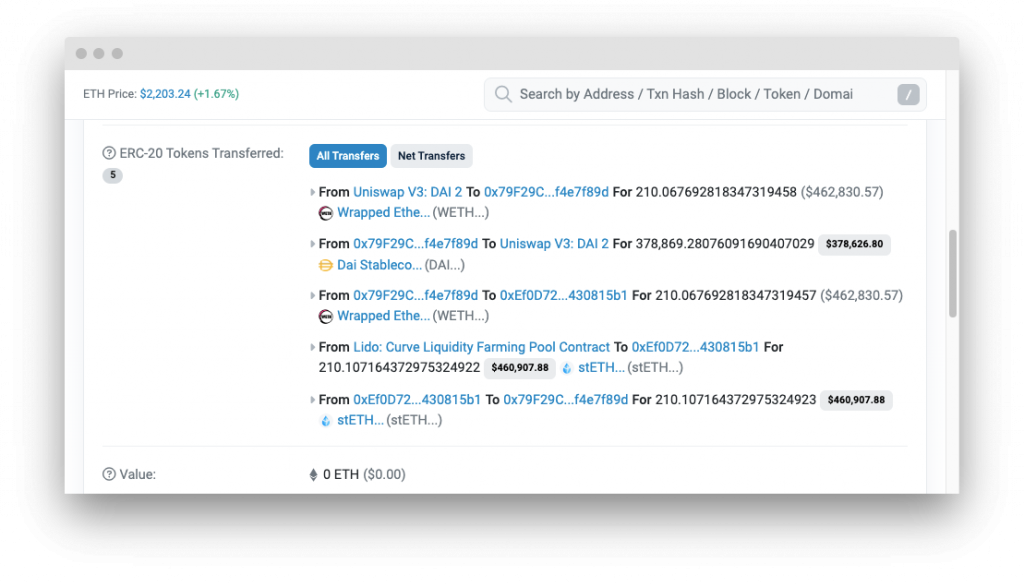
Leveraged liquid staking strategies offer opportunities to maximize yields by leveraging staked assets in various DeFi protocols:

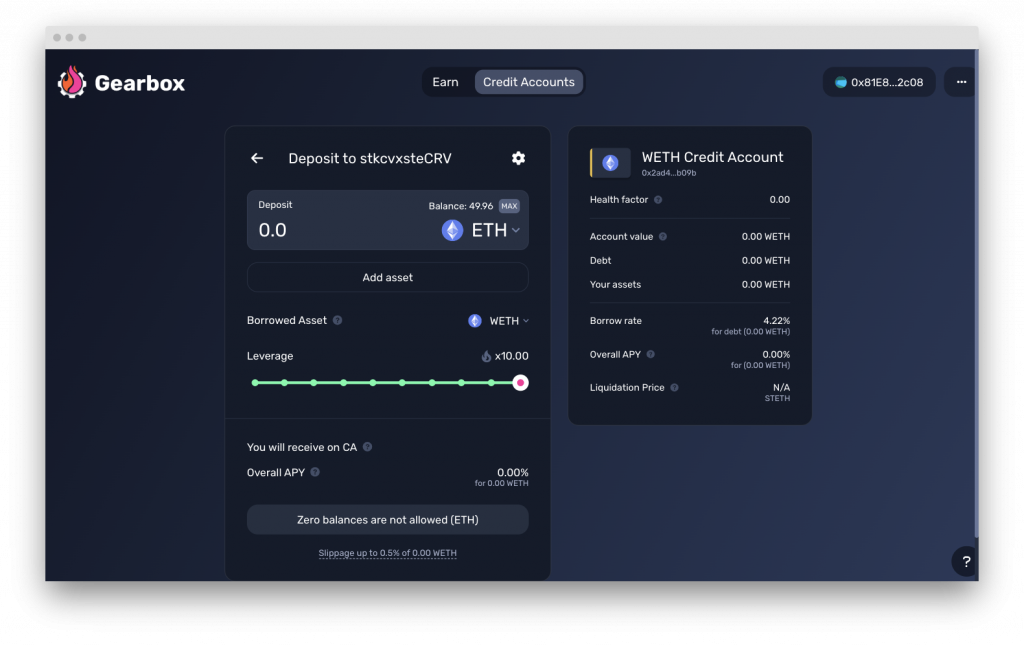
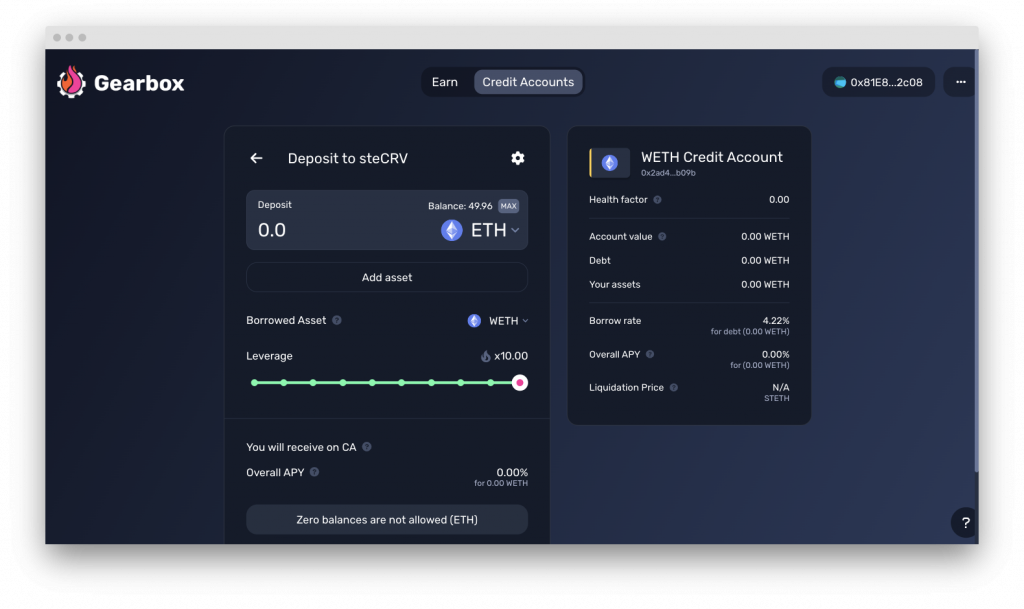
Leveraged Convex offers a strategic approach to liquidity providing (LPing) in pools with potentially higher volatility and APYs. By leveraging assets like $ETH, users can deposit into pools to earn yields from a blend of major cryptocurrencies.
These strategies allow for leveraging various assets to farm in Convex, aiming for enhanced yields compared to direct participation. Current strategies available through Gearbox include:
These strategies highlight the diverse opportunities within the Convex ecosystem for leveraging assets in yield farming. Gearbox simplifies the process, enabling users to deploy capital efficiently across various Convex pools to optimize their yield strategies.
Leveraged vanilla yVaults in the Gearbox enable users to exercise full control over their DeFi strategies, utilizing stablecoins like $USDC and $DAI. These strategies are part of the protocol’s offering to amplify users’ capital, extending up to ten times the leverage for farming in familiar protocols.
Leveraged Restaking (LRTs) through Gearbox is designed to amplify participants’ earnings from staking points, notably from EigenLayer and other liquid restaking protocols. Unlike traditional leverage farming, LRTs allow users to accrue significant points, effectively backdating their participation to the earliest days of the protocol, without requiring specific approvals on Gearbox like the SBT ninja pass needed for other farming integrations on Gearbox. Gearbox has incorporated liquid restaking protocols like Stakewise, Ether.Fi, and Renzo, which cumulatively represent over a billion USD worth of $ETH staked.
Users can engage with Leveraged Restaking through a simplified process:
Gearbox’s Leveraged Restaking model is similar to a two-tranche system but with complete liquidity:
Users of Credit Accounts need to actively manage their investments, monitoring different AVS providers to rebalance their capital for optimal rewards. In contrast, passive liquidity providers (LPs) earn a yield indexed from the best AVS providers, balancing risk and return.
Gearbox thus presents a suite of derivative products atop its restaking platform, catering to both passive earners and active leveraged users, who may encounter negative APYs but stand to gain significant leverage points. This allows users to earn a month’s worth of Eigen points in just four days, showcasing the power of 10x leverage points and airdrops. With a 30% APY or a 2x boost option available, participants can choose their earning strategy based on their risk appetite and investment goals. These ready strategies, such as the 18.0x multiplier for Ether.fi ETH and EigenLayer points, underline the potential of Leveraged Restaking.
Arbitrage strategies in the crypto market can be quite profitable, especially when it comes to assets that are expected to be price-correlated. One common situation is when two stablecoins that are typically pegged 1:1 with the USD diverge in value. Here’s how one might take advantage of such an opportunity using Gearbox and capitalizing on the exchange rate between $ETH and Lido’s $stETH:

Using Gearbox, traders can take advantage of this strategy not only with stablecoins or $ETH LSTs, but also with other assets that tend to have a stable price correlation, like wrapped versions of $BTC. It is important to remember, though, arbitrage involves risk, and profits are never guaranteed. Make sure to fully understand the protocol’s risk disclosures and have a risk management strategy in place before engaging in such activities.
First of all, before diving into leverage farming or margin trading, it is recommended for users to familiarize themselves with the different tabs and functionalities available on the frontend interface.
Once you have familiarized yourself with how the protocol works and you have opened a Credit Account, you can monitor your leverage positions navigating through the different tabs:
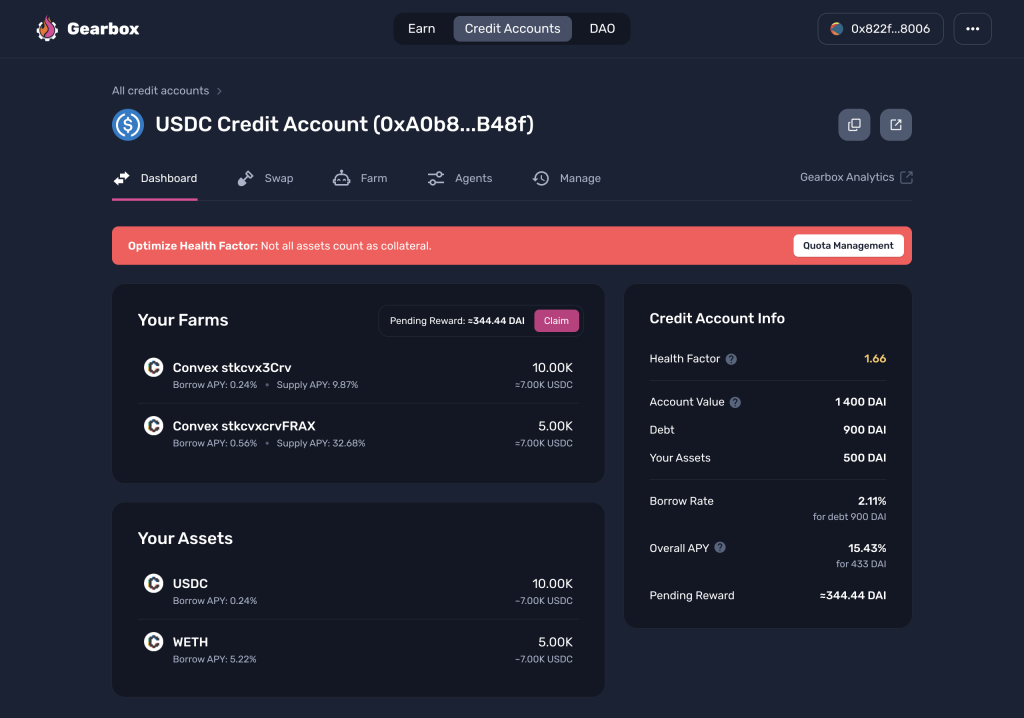
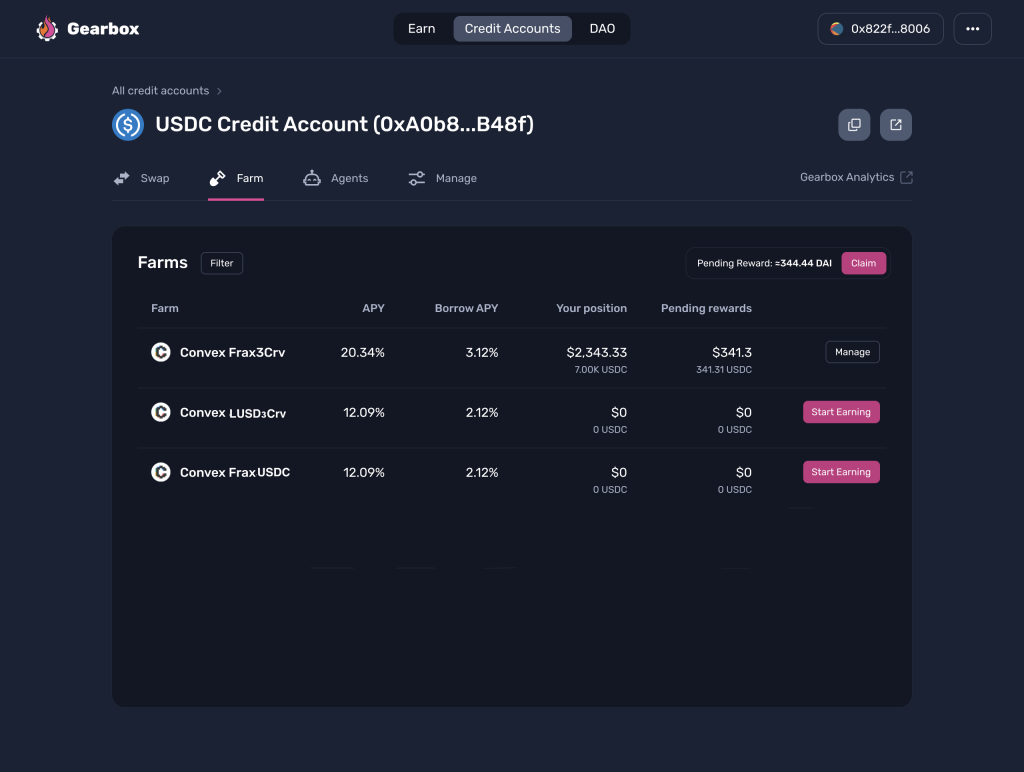

If engaging in margin trading, you should consider the following operations:
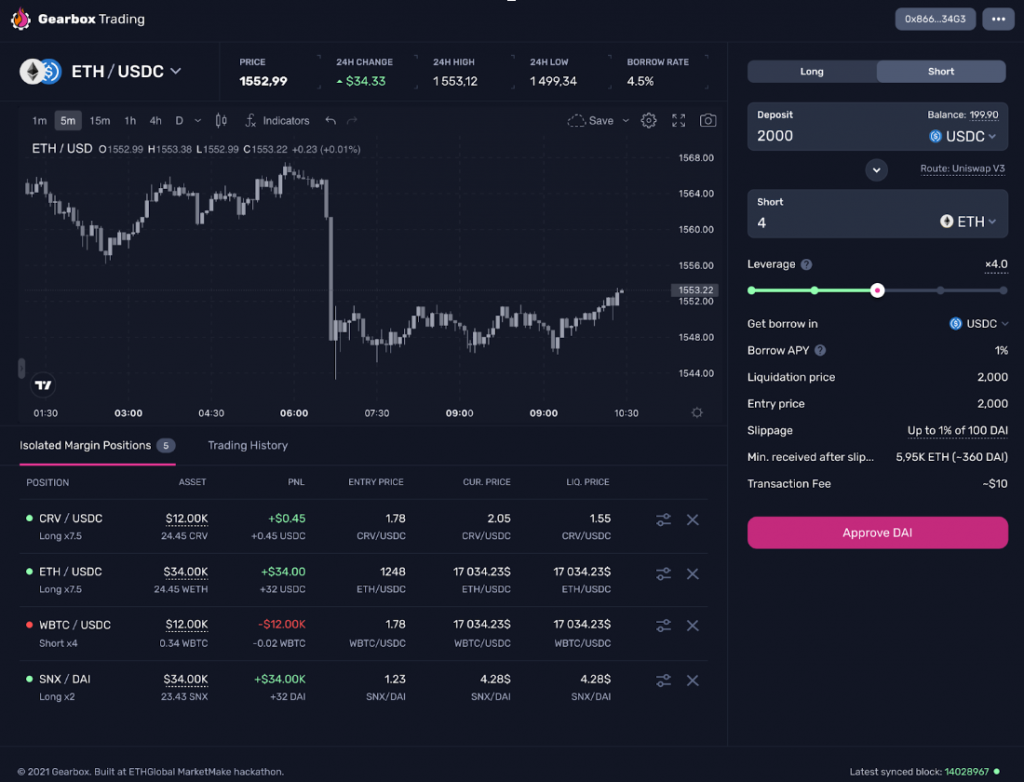
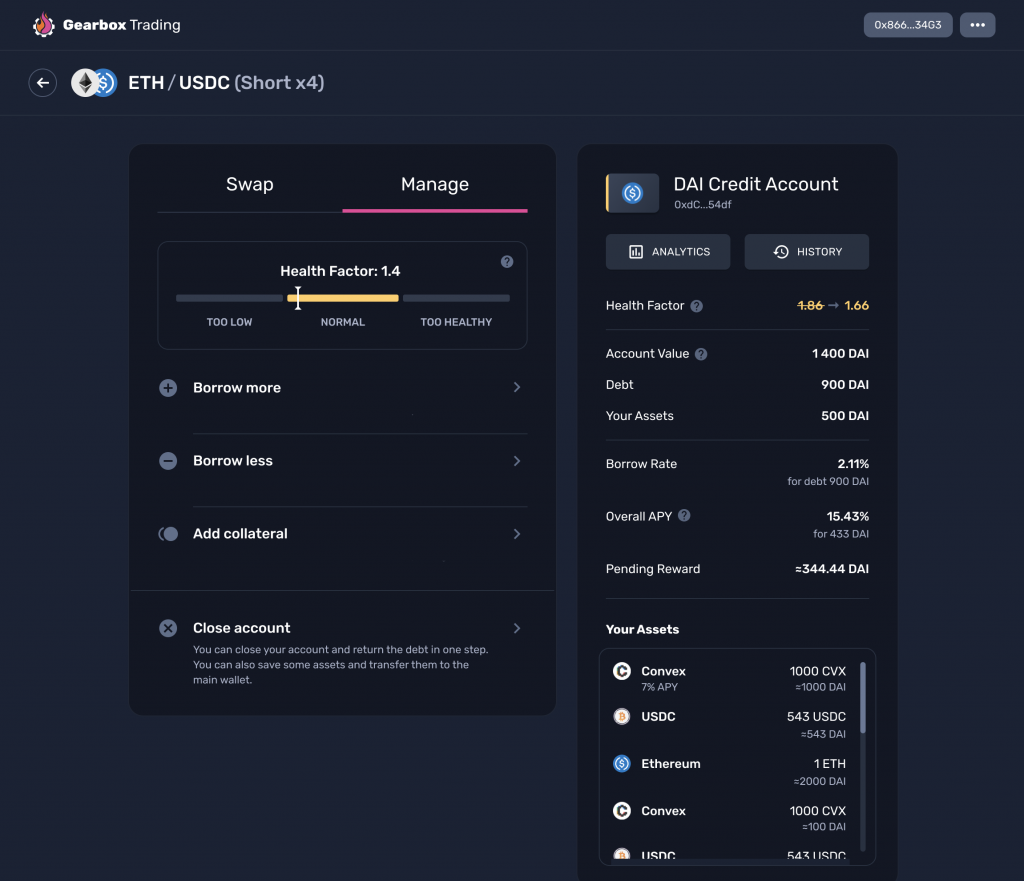
When managing quotas, users should carefully assess their risk tolerance, market conditions, and investment objectives. It’s essential to maintain a balance between maximizing potential returns and protecting against downside risks. Users should regularly monitor their positions and adjust quotas as needed to adapt to changing market dynamics. At all times it is recommended to monitor the account parameters displayed at the top of the interface, including Health Factor, Liquidation Price, Quota Fee, Account Value, Debt, and Your Assets.
| Health Factor (HF) | Your Credit Account can be liquidated if the HF falls below 1. |
| Liquidation Price | The price level at which an account can be liquidated. |
| Quota Fee | The fee that is paid to deploy a position. |
| Account Value | Current value of a Credit Account, denominated in the underlying asset. |
| Debt | The total value of the underlying asset that has been borrowed from the protocol. |
| Your assets | The total value in the underlying asset that is represented by your collateral . |
Other considerations to take into account include:
| Rethink Collateral | In Gearbox, all assets in your Credit Account act as collateral for your debt. Be mindful that even if you start with one asset, swapping it into another changes your collateral composition. |
| Minimum and Maximum Leverage | The minimum leverage is determined by the protocol’s minimum borrow amount, while the maximum leverage is more complex. It’s derived from the Loan-to-Value (LTV) ratio of your assets relative to your debt asset. |
| Calculate Maximum Leverage | Understand your assets’ LTV ratios to calculate the maximum leverage you can take. Consider potential asset price fluctuations to ensure your Health Factor remains above 1, accounting for risks. |
| Manage Risk | When aiming for maximum leverage, exercise caution. Consider factors like slippage, fast price changes, and historical price data to reduce risk exposure. Always be prepared to adjust your leverage based on market conditions. |
| Beware of Slippage | When swapping large amounts, expect slippage. Although it can result in losses, remember that they’re borne solely by your assets in the Credit Account, not the borrowed capital. |
| Claim Rewards | Before closing your Credit Account, ensure you’ve claimed all farming rewards. Unclaimed rewards may transfer to the next user of the account. |
| Understand Liquidations | In Gearbox, liquidation calculations differ from perpetual contracts due to the usage of spot assets. Stay informed about liquidation prices, especially when exercising maximum leverage. |
In Gearbox, collateral operates differently compared to traditional DeFi platforms. Instead of viewing collateral as idle assets that affect borrowing power, Gearbox considers the entire composition of assets in your Credit Account as collateral for your debt, all denominated in the debt asset.
For example, if you initially deposit $ETH and $WBTC but swap them for stablecoins to participate in a stablecoin farm, your collateral becomes the ERC20 representation of that stablecoin farm. This means your starting assets are less relevant; what matters is the assets on your Credit Account denominated in the debt asset.

If you want to maintain an asset as true collateral, such as $ETH, while borrowing stablecoins to increase your borrowing power, you must keep the asset idle in your Credit Account:
Although this approach may reduce capital efficiency since not all your assets are actively utilized, it allows you to retain exposure to ETH’s potential price appreciation, potentially enabling further borrowing against it as its value increases.
In Gearbox, the minimum leverage is determined by the minimum borrow amount, while the maximum leverage depends on various factors, including the Loan-to-Value (LTV) ratio of your positions.
The minimum leverage is essentially the minimum amount of capital you can borrow, while calculating the maximum leverage involves understanding the concept of Loan-to-Value (LTV) ratios. The LTV ratio represents the maximum amount of debt you can take relative to the value of your collateral. For example, if the LTV ratio for a specific farming position is 90%, it means you can borrow up to 90% of the value of your collateral.

For example, if the LTV ratio for a farming position is 90%, the maximum leverage would be:

This means you can borrow up to 10 times the value of your collateral. Keep in mind that higher LTV ratios allow for greater leverage, but they also increase the risk of liquidation if the value of your collateral decreases.
To maximize leverage while maintaining some level of safety, consider an approach where you imagine the worst-case scenarios and assess whether you’re comfortable with the potential outcomes. This will allow you to plan accordingly and mitigate risks by adjusting the desired leverage to account for uncertainty and market fluctuations.
To avoid liquidations, users are encouraged to keep a relatively high Health Factor and ensure that it remains above 1, especially during volatile market conditions.
| Check your HF for Farming | Check your HF for Margin Trading |
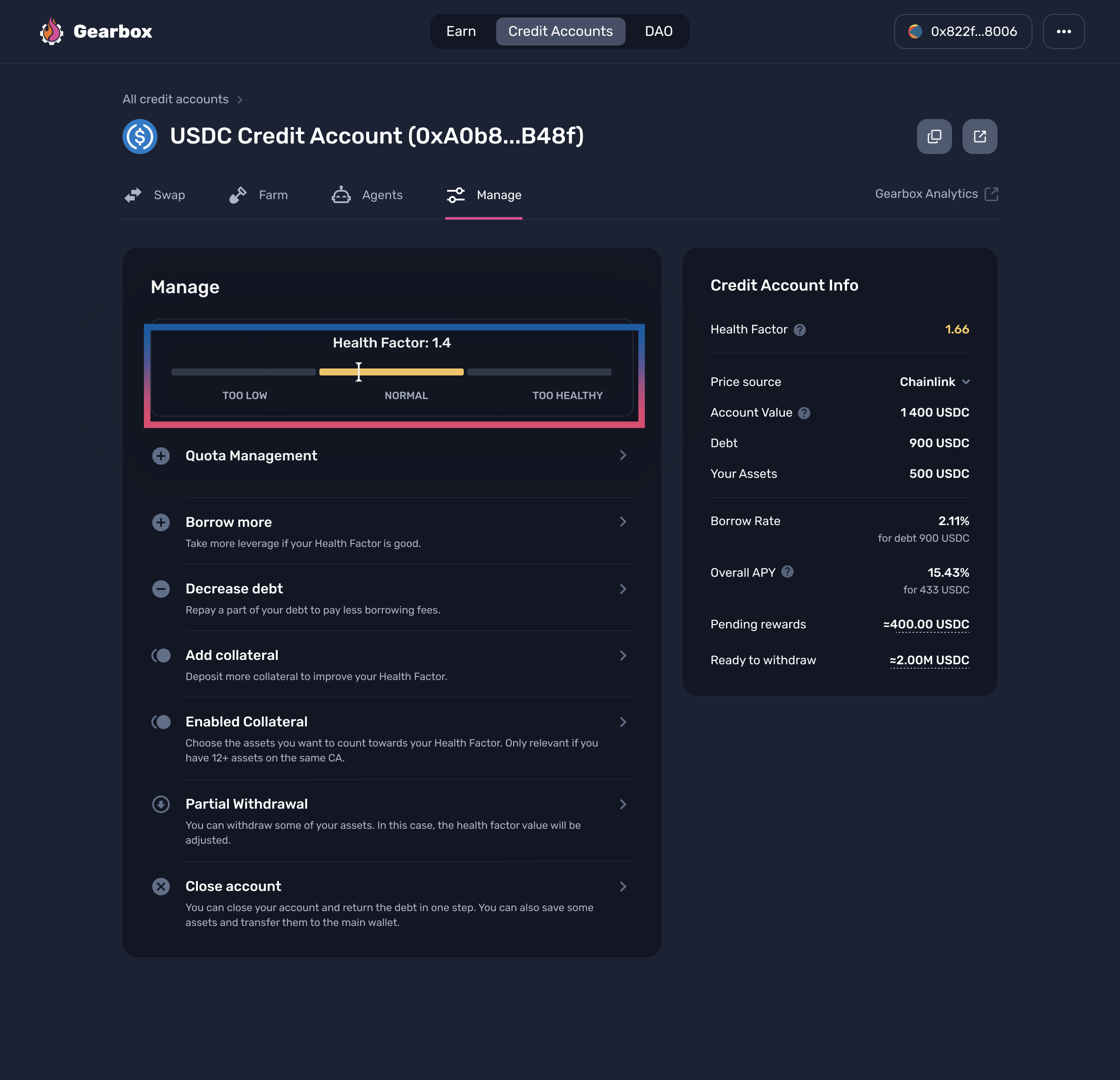 |
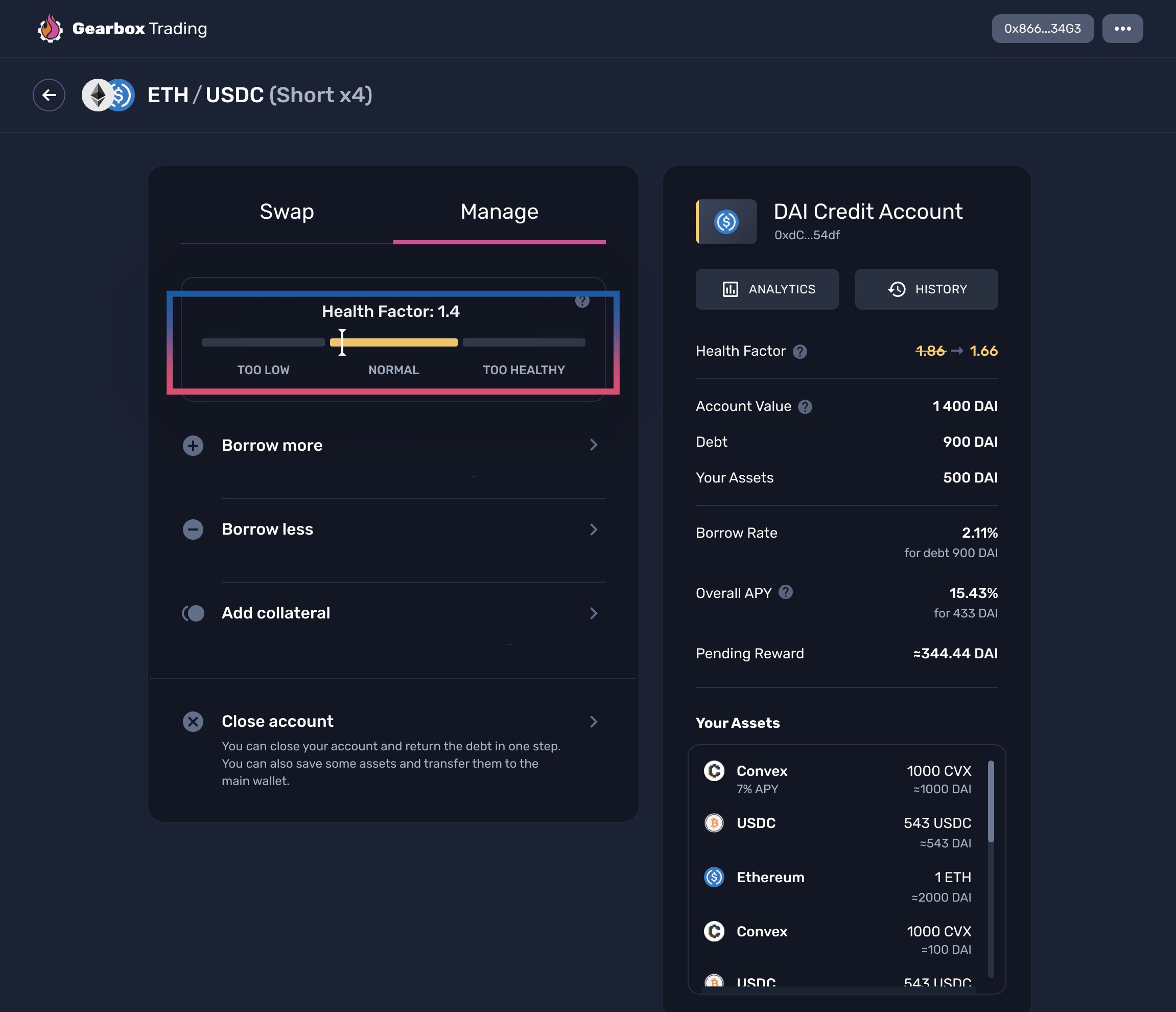 |
Users should also adjust their leverage cautiously, especially in positions with correlated collateral to debt, and be mindful of market fluctuations to avoid over-leveraging and prevent liquidation risk.
You can also increase the collateral in your Credit Account to strengthen your position and improve your HF. Adding more assets as collateral reduces the risk of liquidation. Similarly, you might also consider changing your strategy or farm if your current approach is leading to a drop in HF.
| Add Collateral for Farming | Add Collateral for Margin Trading |
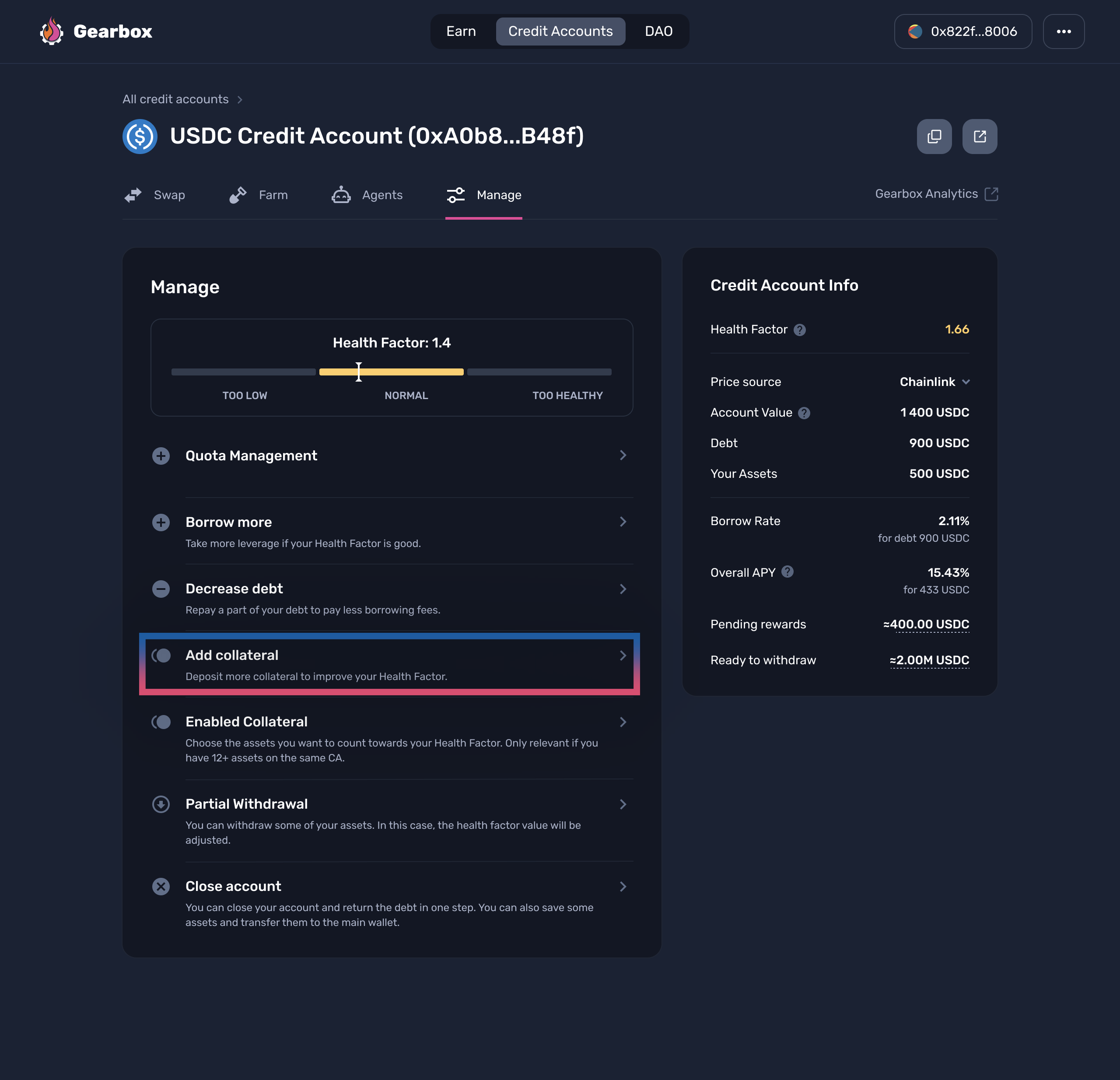 |
 |
Another alternative is to repay part of your debt by adding collateral back to your Credit Account. This reduces leverage and improves your HF, lowering the risk of liquidation.
Closing a Credit Account and avoiding liquidations in Gearbox can be done in two ways:
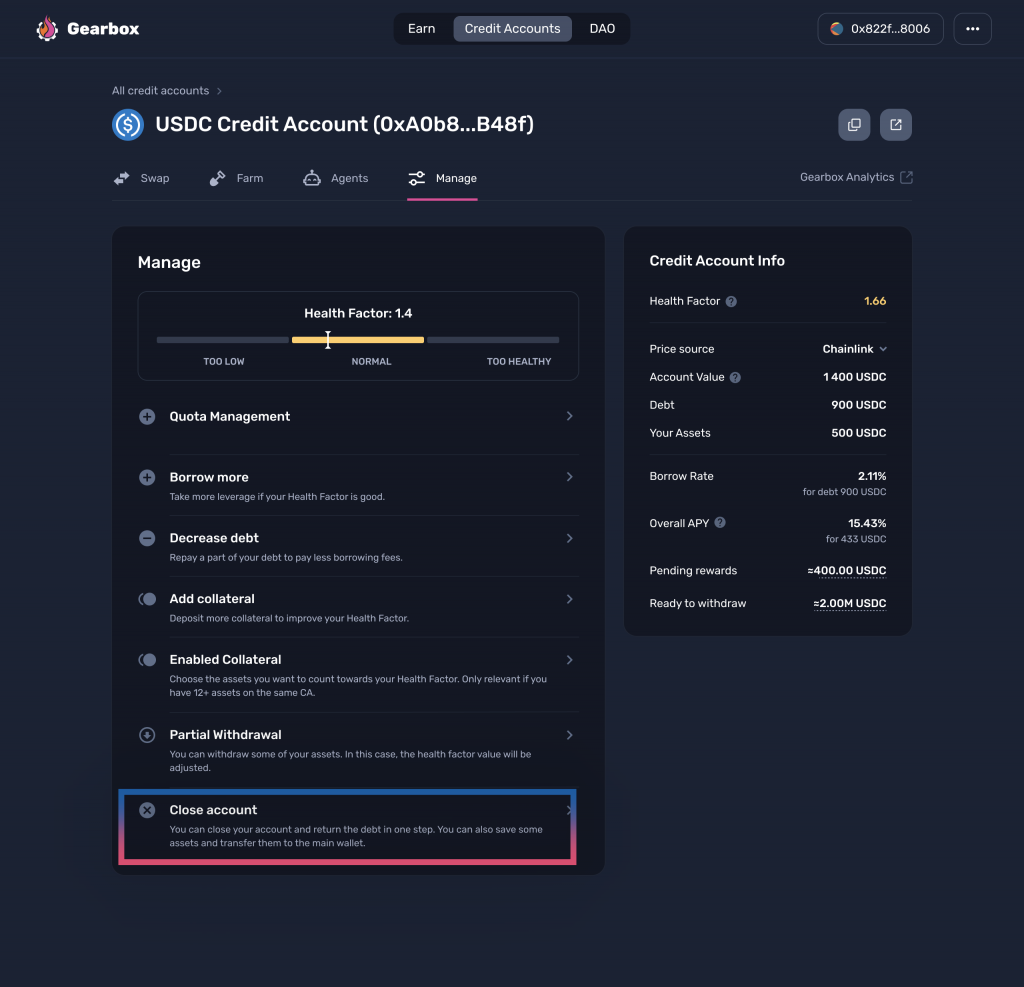
Gauge Voting involves deciding on the extra interest rates, or Quota APY, that borrowers pay for each asset. Unlike the incentives gauges found in other protocols (like Curve), Gearbox’s Gauges are designed as a strategic instrument for fine-tuning the platform’s economic balance. Through Gauge Voting, $GEAR stakers set additional APY rates on top of the protocol’s standard utilization curve. This dynamic tool empowers stakers to manage the risk-reward ratio thoughtfully and proactively.
The impact of Gauge Voting spans various user types within the protocol:
Stakeholders can reallocate their votes anytime within an epoch, fostering a governance model that’s both responsive and reflective of a collective strategy. The additional APY rates agreed upon are implemented per block, akin to standard borrowing rates.

$GEAR stakers are instrumental in shaping Gearbox’s economic incentives, balancing lender returns against borrower costs, and managing the protocol’s exposure to riskier collateral types. Their decisions in Gauge Voting are central to the protocol’s financial equilibrium.
Gauge Voting is structured around epochs, each lasting typically 7 days, with new epochs commencing every Monday at 12:00 UTC. This regular cadence ensures a predictable governance process, where the additional APY rates, once set, apply per block like regular borrow rates until the epoch concludes.
A lock-in period is in place for withdrawing staked $GEAR to ensure the protocol’s stability. Currently, a withdrawal requires a four-epoch waiting period, equating to 28 days. This safety measure prevents abrupt changes that could impact the health of the protocol, maintaining a stable governance environment.
Gearbox’s business model leverages the creation and management of Credit Accounts for users, enabling various financial activities such as lending, borrowing, and asset management on-chain.
The protocol is designed to operate autonomously, governed by community consensus through on-chain governance mechanisms. The $GEAR token serves as the governance token of the Gearbox ecosystem, allowing token holders to participate in protocol governance decisions, stake their tokens for rewards, and access platform features. $GEAR tokens also play a role in determining protocol fees and incentives.
Gearbox prioritizes community involvement and governance participation, empowering users to shape the direction of the protocol. Community members can propose and vote on protocol upgrades, fee adjustments, and other initiatives through transparent and decentralized governance processes.
Protocol fees in Gearbox are designed to support the sustainability and growth of the ecosystem while ensuring fair compensation for various operations.
All protocol fees earned by the DAO go to the fee guard, and nothing is assumed to be reserved for contributors. The protocol is fully operated by $GEAR token holders through the DAO.
Most of the fees are static and voted via governance, although Gauges are voted separately on a per-epoch basis on each separate chain. Also, since Gearbox interacts with many different protocols and assets, these fees will be paid out and denominated on different tokens.
| Fee | Description |
| Liquidation Fee | When a Credit Account is liquidated, a percentage of the liquidation proceeds is allocated to the third-party liquidator, while another percentage goes to the Gearbox DAO. |
| Base APY Rate | The DAO takes a spread as a fee between the APY received by lenders and the fee paid by borrowers for borrowing assets. |
| Quote APY Rate | Gauges apply an extra quota interest rate to each asset separately, with rates determined by $GEAR stakers through separate voting. |
| Quota Rate Flat Fee | This fee is applied when users buy a quota, such as when entering a position for the first time, rebalancing assets within an existing position, or adjusting leverage. The fee varies depending on the asset and can differ between Credit Managers. The entirety of this fee is allocated to the DAO. |
Since Gearbox has two sides to its operations, the amount of fees being paid depends on what type of user you are: a passive lender or a borrower.
There are no direct fees for passive lenders. Borrowers accessing leverage pay a borrow interest rate (which fluctuates based on pool utilization) and dynamic Quotas, as well as a liquidator fee split between the third-party liquidator and the protocol (only if the Credit Account is liquidated).
Quotas and gauges are also integral components of the governance and fee structure within the protocol, playing pivotal roles in managing collateral exposure and determining borrowing costs. Quotas function akin to individual credit limits, serving as a mechanism to regulate the maximum exposure a Credit Account can have to a specific collateral asset. They operate on a per-account basis, dictating the extent to which assets can be utilized as collateral. Essentially, quotas establish boundaries to ensure responsible leveraging within the protocol. These limits are determined by the main governance process, reflecting the collective decision-making of stakeholders.
Conversely, gauges influence the additional interest rates borrowers must pay on their quotas. Unlike quotas, which establish fixed limits, gauges are dynamic and subject to change based on periodic epochs, typically spanning seven days. $GEAR token holders participate in the governance process by staking their tokens and voting to set these rates. The rates established by gauges serve to adjust borrowing costs, with higher rates increasing the expense for borrowers and lower rates reducing it.
Gearbox features the $GEAR token, an ERC20 utility token that began as a governance token and may evolve with new functionalities as determined by the DAO. The total supply of $GEAR is fixed at 10B and is immutable as per the protocol’s smart contract.
The DAO, holding over 40% of the total supply, allocates approximately 3% annually towards initiatives and liquidity mining, with a long-term goal of reducing this percentage. The DAO’s distributions are detailed in the Gearbox documentation and encompass grants and rewards without introducing new inflation.
Vesting began in 2022 and is nearing completion as of 2024. The DAO’s share has decreased from over 55% to about 40%, following multiple reward distributions. With vesting for 2024 nearly complete, the $GEAR supply is approaching full circulation.
Gearbox Token Distribution

Community DAO Portion: 58%
The Community DAO Portion forms the backbone of Gearbox’s governance, empowering the community with the majority of the voting power. This segment is not subject to vesting, ensuring immediate influence for community members.
Subcategories within the Community DAO Portion:
A special allocation is reserved for the individuals who contributed significantly to Gearbox’s technical development without direct capital investment. These contributors are rewarded with a 1.28% stake, subject to a 12-month lockup from the token deployment date, followed by an 18-month linear vesting period ending in June 2024.
Early backers, pivotal to the protocol’s initial phases, are allocated 9.20% of the $GEAR supply. Contrary to traditional investor roles, these backers dedicated not just capital but substantial time and effort, blurring the lines between investors and active contributors. Following a 12-month lockup post-launch, their shares underwent a 12-month linear vesting process, emphasizing their foundational role in the protocol’s evolution.
Recognizing the core team’s instrumental role, 20% of the $GEAR supply is allocated to these individuals. The DAO’s emergence during the launch redefined traditional team dynamics, with a 12-month lockup and an 18-month vesting period ensuring long-term commitment.
The initial company wallet, holding 11.52% of the $GEAR supply, facilitated the protocol’s early development stages before the DAO’s formation. This portion, locked for 12 months and vested over 18 months ending in June 2024, supported pre-DAO activities, including onboarding contributors and engaging auditors.
Gearbox champions transparency and trustlessness, allowing all token distributions and vesting contracts to be verified on-chain. This approach ensures that community members can independently verify allocations, reinforcing the protocol’s commitment to openness.
The $GEAR token, an ERC20 utility token integral to the Gearbox, serves multiple roles within the ecosystem, primarily starting as a governance token. Its utility has been designed to expand based on the evolving needs and decisions of the DAO.
The Gearbox DAO invites all $GEAR holders to explore the existing utility sinks, propose new ones, or even develop their own staking contracts. This participatory model not only diversifies the token’s utility but also empowers the community to shape the protocol’s future actively.
Gearbox thrives on a community-driven governance model, empowering $GEAR token holders to shape the protocol’s future. The governance framework is designed to be inclusive, transparent, and adaptable, ensuring that all stakeholders have a voice in critical decisions affecting the protocol. Governance activities include:

Reverse Voting Escrow and Delegation: To mitigate the influence of large token holders and ensure a balanced governance process, Gearbox employs mechanisms like reverse voting escrow and delegation. These tools adjust voting power to amplify the voice of the wider community, promoting fairness and inclusivity.
Thresholds, Quorums, and Cool-off Periods: Governance proposals are subject to specific thresholds and quorums to ensure legitimacy and broad community support. Additionally, cool-off periods are implemented to prevent proposal spamming and give the community ample time to consider each decision carefully.
Community Engagement and Delegates: Community delegates play a pivotal role in aggregating smaller token holders’ voices, ensuring that governance remains accessible to all. By delegating votes, community members can contribute to the decision-making process, even if they cannot be actively involved 24/7.
Gearbox DAO’s governance model is an ever-evolving process, with the community continuously exploring ways to enhance participation and effectiveness. The protocol’s commitment to transparency is evident in all governance activities, from proposal discussions to the execution of community decisions.
The Guardians Initiative and Multisig Signers encompass a crucial aspect of decentralized governance, dividing responsibilities between financial-treasury and technical sectors to safeguard both the protocol’s fiscal health and technical soundness. Initially created by core members before the protocol’s deployment, these multisigs are instrumental in executing proposals endorsed by the DAO’s token holders. They embody the delegated trust and accountability, underscored by the DAO’s governance model, to carry out decisions that have reached a quorum.
The Technical Guard is responsible for implementing proposals related to technical changes within the protocol. This multisig is composed of members known for their contributions to the DeFi ecosystem.
This multisig shares the same set of signers as the Technical Guard but requires a lower threshold (4/12) for faster responses, especially in critical situations.
The Treasury Guard executes decisions regarding spending, grants, and overall treasury management.
A temporary multisig with the same members as the Treasury Guard, created to manage funds from the DAO rounds used for protocol development.
These roles and members illustrate the protocol’s commitment to decentralized governance and the high degree of trust placed in these individuals to steer the protocol in accordance with the community’s will, while ensuring security and integrity.
Becoming a delegate in Gearbox’s governance or delegating your $GEAR takes just a few simple steps:
| To Delegate $GEAR | To Become a Delegate |
| Choose a delegate you trust and align with their strategic ideas. | Have an active Discord profile and optionally, X. |
| Go to the delegation page on the Gearbox interface and connect your wallet. | Participate in contributor calls and discussions to stay informed. |
| Insert the delegate’s address or ENS and confirm. This incurs a small gas fee. | Be reachable for questions and share your viewpoint on various topics. |
| Your $GEAR is not locked, and you can freely undelegate or move them at any time. | Engage in forum and Discord discussions to fulfill your governance role effectively. |
Introduced on August 15, 2023, the Gearbox Risk Foundation (GRF) underscores Gearbox’s commitment to transparency and proactive risk management. This initiative aligns with Gearbox’s broader strategy to mitigate inherent DeFi risks through comprehensive audits, a robust risk management framework, and strategic use of over-collateralization and insurance mechanisms.
The Reserve Fund is strategically designed to address under-collateralization issues stemming from incorrect liquidations, providing a safety net for liquidity providers. It’s crucial to note that this mechanism does not extend to covering losses from actual software hacks, delineating its scope to operational risk mitigation related to liquidation processes.
Unlike traditional protocols that hold idle assets, Gearbox’s reserve fund operates through a dynamic model leveraging protocol-owned assets to actively support its operations and liquidity providers.
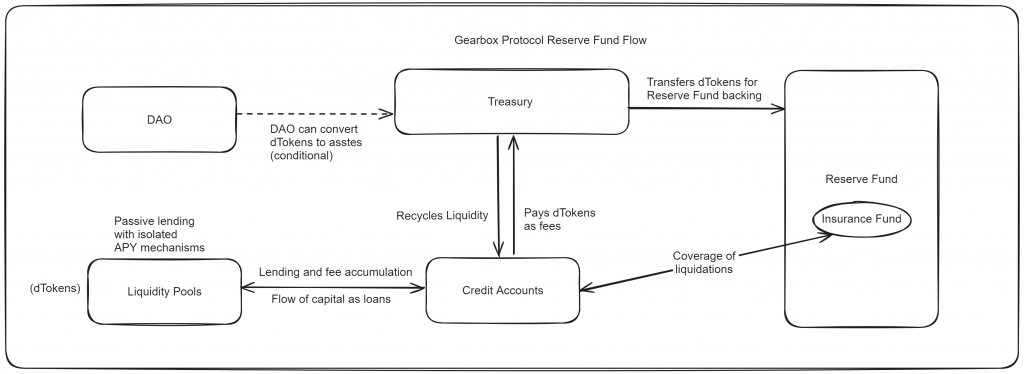
The Gearbox DAO holds the power to refine and expand the Reserve Fund model, offering a flexible framework to adapt to the evolving needs of the protocol and its community. This adaptability ensures Gearbox can maintain its resilience and support for liquidity providers in the face of market dynamics and operational challenges.
Gearbox’s commitment to security is evident through its comprehensive audit history and proactive bug bounty program. However, it’s essential to recognize that despite rigorous audits, no protocol can claim absolute safety. The intrinsic risks of DeFi, compounded by the interdependencies of various platforms, underscore the importance of user awareness and caution. Gearbox does not guarantee returns, and users are encouraged to fully grasp the associated risks.
Audits:
Bug Bounty Program with ImmuneFi: Gearbox encourages the community and security researchers to actively participate in identifying potential vulnerabilities through its bug bounty program. This initiative underscores the protocol’s dedication to security:
Here’s a detailed look at the reward structure for each severity level of the bug bounty program:
The Gearbox DAO is the cornerstone of the protocol, embodying the principles of decentralization from inception. Without a core team dictating its trajectory, the DAO has been steering the protocol since its launch, with the community at the helm of decision-making.
Contributing to the DAO doesn’t require round-the-clock activity. Community members are encouraged to engage according to their capacity, leveraging the DAO’s tools and resources to contribute meaningfully. Detailed initiatives and potential contributions are outlined on the Gearbox Notion page, inviting collaboration and community funding.
Gearbox is a testament to collective governance. From the deployment of the protocol to the meticulous configuration of pools and assets, the DAO ensures that every voice can contribute to the protocol’s evolution. This is facilitated through the use of Snapshot and community multisigs, which together form a robust system for proposal voting and execution.
The DAO’s governance framework is crafted to balance the influence across its constituency. It employs strategies like reverse voting escrow and voting delegation to moderate the weight of larger token holders, promoting equity within the community. These mechanisms ensure that every $GEAR token holder, regardless of their stake size, can impact the protocol’s future.
The decision-making flows from community ideation on Discord to formal voting via Snapshot, culminating in the multisig guard’s execution of proposals that achieve the required quorum. This process allows the DAO to maintain a transparent and verifiable process through on-chain verification. This ensures trust in the system, where all actions and decisions can be scrutinized without the need for intermediaries.
The DAO operates on a cycle of initiatives that encompasses proposal submission, funding allocation, and reporting. Each cycle fosters a dynamic governance environment where proposals are evaluated, executed, and reviewed periodically, ensuring continuous adaptation and improvement.
Gearbox is a collective effort, driven by the contributions of numerous individuals rather than a conventional team structure. The project thrives on the early involvement of various experts who have shaped its development and growth.
Gearbox has been supported by a diverse group of early backers, including DAOs, venture capital firms, and individual contributors who have played a pivotal role in the development and growth of the protocol.
What is the utility of the GEAR token within the Gearbox?
What fees are users paying?
What are dTokens on Gearbox?
How does the APY change based on liquidity conditions and/or demand for leverage?
How can users avoid getting liquidated?
Can users always withdraw their liquidity?
What is the Health Factor and why is it important?
Why might users be restricted from borrowing more?
Why does swapping one stablecoin for another decrease the Health Factor?